
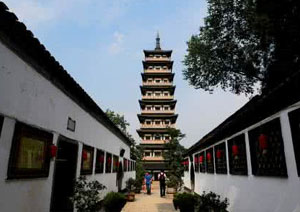 Daming Temple, located on a hillslope in the northwestern suburb of Yangzhou.It is one of the oldest temples in the City, having a history of over 1,500 years.Once Emperor Qianlong by the Qing dynasty toured Yangzhou and was unhappy to see the name of the temple "Daming", for he took it to mean "great Ming". (Ming dynasty was ruled by the Manchus, a minority. Qing succeeded Ming.) For fear that it might remind people of the Ming dynasty, he renamed the temple “Fajing Temple” and put it down in his own handwriting. (Emperor Qianlong was a good calligrapher.) In the spring of 1980, in reparation for the exhibition of the statue of MonkJian Zhen, the Yangzhou Municipal Government hanged it back to "Daming Temple" ... ...
Daming Temple, located on a hillslope in the northwestern suburb of Yangzhou.It is one of the oldest temples in the City, having a history of over 1,500 years.Once Emperor Qianlong by the Qing dynasty toured Yangzhou and was unhappy to see the name of the temple "Daming", for he took it to mean "great Ming". (Ming dynasty was ruled by the Manchus, a minority. Qing succeeded Ming.) For fear that it might remind people of the Ming dynasty, he renamed the temple “Fajing Temple” and put it down in his own handwriting. (Emperor Qianlong was a good calligrapher.) In the spring of 1980, in reparation for the exhibition of the statue of MonkJian Zhen, the Yangzhou Municipal Government hanged it back to "Daming Temple" ... ...
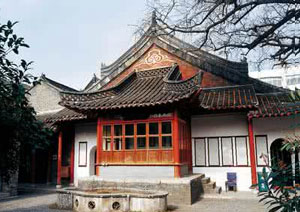 The Fairy Crane Mosque is one of the four famous old mosques in China (the others are Huaisheng Mosque in Guangzhou, Guangdong Province, Fenghuang Mosque in Hangzhou, Zhejiang Province and Qingjing Mosque in Quanzhou, Fujian Province). It was first built in 1275 to serve the needs of the Arab traders and was rebuilt twice in the Ming Dynasty. Its ancient pine and gingko trees are believed to be around 800 years old. The mosque is supposed to resemble a crane in shape: the main entrance is the head; the wells on either side, the eyes; the left-hand path, the neck; the prayet hall, the body; the north and south halls, the wings.....
The Fairy Crane Mosque is one of the four famous old mosques in China (the others are Huaisheng Mosque in Guangzhou, Guangdong Province, Fenghuang Mosque in Hangzhou, Zhejiang Province and Qingjing Mosque in Quanzhou, Fujian Province). It was first built in 1275 to serve the needs of the Arab traders and was rebuilt twice in the Ming Dynasty. Its ancient pine and gingko trees are believed to be around 800 years old. The mosque is supposed to resemble a crane in shape: the main entrance is the head; the wells on either side, the eyes; the left-hand path, the neck; the prayet hall, the body; the north and south halls, the wings.....
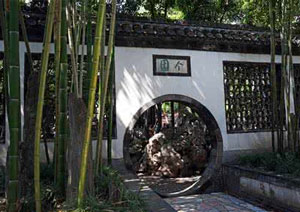 Geyuan Garden located on the northern side of Dongguan Street of Yangzhou city, was rebuilt by General Manager Huang Zhiyun, a local salt industry official on a ruin in the 23rd year of Qing Dynasty Emperor Jiaqing's reign (1818). Bamboo leaves in the gardon look like the Chinese character--个(Ge), hence the name Geyuan Garden.Geyuan Garden located on the northern side of Dongguan Street of Yangzhou city, was rebuilt by General Manager Huang Zhiyun, a local salt industry official on a ruin in the 23rd year of Qing Dynasty Emperor Jiaqing's reign(1818). Bamboo leaves in the gardon look like the Chinese character--个(Ge), hence the name Geyuan Garden.....
Geyuan Garden located on the northern side of Dongguan Street of Yangzhou city, was rebuilt by General Manager Huang Zhiyun, a local salt industry official on a ruin in the 23rd year of Qing Dynasty Emperor Jiaqing's reign (1818). Bamboo leaves in the gardon look like the Chinese character--个(Ge), hence the name Geyuan Garden.Geyuan Garden located on the northern side of Dongguan Street of Yangzhou city, was rebuilt by General Manager Huang Zhiyun, a local salt industry official on a ruin in the 23rd year of Qing Dynasty Emperor Jiaqing's reign(1818). Bamboo leaves in the gardon look like the Chinese character--个(Ge), hence the name Geyuan Garden.....
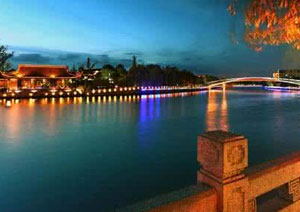 At 1,800km (1,116 miles), the Grand Canal is the longest canal in the world. Together with the Great Wall of China, this waterway, which runs from Beijing to Hangzhou, is one of China's great engineering feats. The first 85km (52 miles) were constructed as early as 495 B.C., but the Herculean task of linking the Yellow River and Yangtze River began in earnest in the early 7th century, when the second Sui dynasty Yang Di emperor had the waterway dug from his capital at Luoyang to Beijing in the north and to the Yangtzei River basin. Due to the differences in terrain and water levels, locks and dams had to be built along the way.
At 1,800km (1,116 miles), the Grand Canal is the longest canal in the world. Together with the Great Wall of China, this waterway, which runs from Beijing to Hangzhou, is one of China's great engineering feats. The first 85km (52 miles) were constructed as early as 495 B.C., but the Herculean task of linking the Yellow River and Yangtze River began in earnest in the early 7th century, when the second Sui dynasty Yang Di emperor had the waterway dug from his capital at Luoyang to Beijing in the north and to the Yangtzei River basin. Due to the differences in terrain and water levels, locks and dams had to be built along the way.
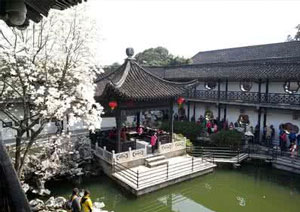 At 1,800km (1,116 miles), the Grand Canal is the longest canal in the world. Together with the Great Wall of China, this waterway, which runs from Beijing to Hangzhou, is one of China's great engineering feats. The first 85km (52 miles) were constructed as early as 495 B.C., but the Herculean task of linking the Yellow River and Yangtze River began in earnest in the early 7th century, when the second Sui dynasty Yang Di emperor had the waterway dug from his capital at Luoyang to Beijing in the north and to the Yangtzei River basin. Due to the differences in terrain and water levels, locks and dams had to be built along the way.
At 1,800km (1,116 miles), the Grand Canal is the longest canal in the world. Together with the Great Wall of China, this waterway, which runs from Beijing to Hangzhou, is one of China's great engineering feats. The first 85km (52 miles) were constructed as early as 495 B.C., but the Herculean task of linking the Yellow River and Yangtze River began in earnest in the early 7th century, when the second Sui dynasty Yang Di emperor had the waterway dug from his capital at Luoyang to Beijing in the north and to the Yangtzei River basin. Due to the differences in terrain and water levels, locks and dams had to be built along the way.
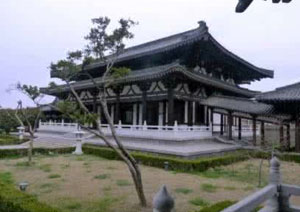 The ancient Tangchneng City Ruins is located at Shugang Hill, the northwest of the outskirts of Yangzhou City. During the Eastern Zhou Dynasty, Fuchai, the lord of the Wu State, began to build up the city of Han to contend for the hegemony over the central plain region. Later in the Han Dynasty, the city of Guangling was constructed. And even later in 783 A. D., the city was extended to the Shugang Hill. Currently, the relics of the city are being well preserved as well as the the moat of the Tang city.
The ancient Tangchneng City Ruins is located at Shugang Hill, the northwest of the outskirts of Yangzhou City. During the Eastern Zhou Dynasty, Fuchai, the lord of the Wu State, began to build up the city of Han to contend for the hegemony over the central plain region. Later in the Han Dynasty, the city of Guangling was constructed. And even later in 783 A. D., the city was extended to the Shugang Hill. Currently, the relics of the city are being well preserved as well as the the moat of the Tang city.
Shouxihu Lake
Shou Xi Hu, known as "Slender West Lake" is one of Yangzhou's largest and most striking sights. The graden's layout gave rise to its name - it runs along both sides of a remarkably slender lake which snakes through the north part of the city,. Connoisseurs of gardens admire it because it combines the elegant presentation and careful planning of a small garden with the landscape and scenery of a larger lake.Although now it is one of the most famous and admired gardens in China, it was once just a narrow river. During the 18th century, the Emperor Qianlong was planning a trip from Beijing to visit the cities of central China......

